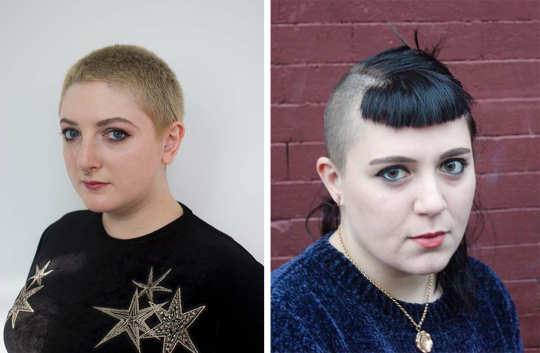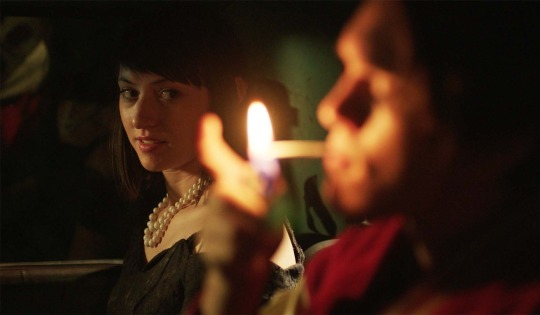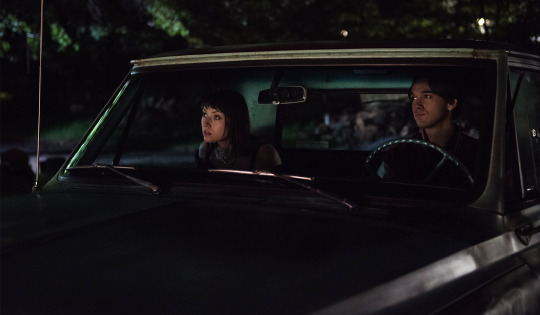Conversations | Carlen May-Mann’s “The Rat” Goes to the 2019 Sundance Film Festival

“It was important to me to take the film out of the darkness, and to explore spaces where, although the colors are bright and people are laughing, the horror from the house still lingers.”
“It’s Halloween night, and Renee is madly in love with Jim…”–that’s the premise for the new short horror film, The Rat, which takes the viewers into an eerie haunted house by following a young couple in love. The movie, set like a traditional slasher film, creates expectations of intrusion and surprise. But director and writer Carlen May-Mann, an emerging filmmaker who seeks to challenge the status quo and create social change, subverts the horror genre in The Rat by taking a refreshing twist to re-casting the narrative towards fears that exist underneath our everyday lives.
The Rat premieres at the 2019 Sundance Film Festival this week and is a loose companion piece for a longer, feature-length horror film, Strawberry Summer (co-written by Beck Kitsis), that is slated for production later in 2019. Strawberry Summer’s narrative centers around a young girl’s coming-of-age and being confronted with the dangers of predatory boys and men as she turns 14. Both films are Fiscally Sponsored by NYFA.
NYFA had the opportunity to speak with Carlen May-Mann and Beck Kitsis, producer of The Rat and co-writer/producer of Strawberry Summer, about the concept behind this pair of films and their vision for the horror genre. Read the interview below.
The Rat screens in the Shorts Program 4 at the Sundance Film Festival beginning Friday, January 25, 2019. See the full screening schedule here.

NYFA: How would you describe the visual style of The Rat?
Carlen May-Mann (Director and Writer): To be cheeky, I would describe the style of The Rat as Val Lewton meets Psycho in 1984.
The joy of making a haunted house film is that there is so much iconography to work from. I looked to the Bates Manor, Manderley, the Amityville Horror house, and to recent examples like The Others and The Babadook. There were basics that I knew needed to be there (peeling wallpaper, creaking stairs, a slow-moving, creeping camera) that evoke horror on sight. But this film doesn’t exist entirely in that world. It was important to me to take it out of the darkness and to explore spaces where, although the colors are bright and people are laughing, the horror from the house still lingers.

NYFA: Why write horror? What challenges or opportunities does writing horror give that non-horror films do not?
CMM: Throughout the history of cinema, horror has been used as a subversive tool, a way of calling out for social change. As someone who believes it is imperative to address social issues in art, I was drawn to horror as I struck out on my own as a filmmaker.
Scaring people is not something that should be taken lightly, both in art and in life. Horror filmmakers, myself included, should constantly be asking ourselves why we are putting our audiences in this vulnerable state.

NYFA: Do The Rat’s main characters, Jim and Renee, represent archetypes from film tradition?
CMM: My hope with The Rat is that, at first, the viewer conceives of Jim and Renee as the sort of couple who inhabit an ’80s slasher flick: young, “All American,” a touch too bold for their own good, and therefore doomed. These characters often suffer horrible deaths, but the viewer isn’t asked to care much about their demises past the point of superficial shock.
It’s a unique asset to have genre- and cultural-based archetypes of horror behind me. I can use these conventions when they are helpful to me, and subvert them when they’re counter to what I’m trying to convey. It is important to the viewing of The Rat that viewers use their preformed expectations to inform these characters, until the twist of the film, when they are unable to do so anymore and must reexamine the biases that they brought with them.
NYFA: You commissioned original music from the indie-pop band Told Slant. How does the music shape the mood and style of the film?
Beck Kitsis (Producer): I met Told Slant a.k.a. Felix Walworth through playing music around New York City. My old band The Meltaways played a show with their project Told Slant at the Silent Barn in 2016. Around that same time, Carlen and I were beginning to develop projects centered on the emotional sting of growing up, and I thought back to Felix’s music, which also explored some of that same emotional rawness.

NYFA: How is The Rat’s narrative similar or different to the upcoming film, Strawberry Summer?
BK: For me, the biggest difference between the two films comes from the worlds each character inhabits. For The Rat, this is a world like ours, where well-intentioned men sometimes scare us to the point of becoming literal monsters. For Strawberry Summer, this is a world where men are born monsters, one where we have to wake up and recognize them as a threat so that we can protect ourselves.
NYFA: Why did you choose NYFA Fiscal Sponsorship?
BK: We chose NYFA because we wanted to collaborate with an organization that would give us the tools to chase after bigger grants and support our greater social impact mission. As our project has progressed, NYFA has been there every step of the way, so we are extremely happy with our partnership. NYFA was the first organization to get behind Strawberry Summer, and that means a lot to us.
– Interview conducted by Priscilla Son, Program Associate, Fiscal Sponsorship & Finance
Are you an artist or a new organization interested in expanding your fundraising capacity through NYFA Fiscal Sponsorship? We accept out-of-cycle reviews year-round. No-fee applications are accepted on a quarterly basis, and our next deadline is March 31. Click here to learn more about the program and to apply.
Image Credits: (From top to bottom) Film Still, Matt Harvey; Bio Photos of Carlen May-Mann and Beck Kitsis from left to right, courtesy of Danni Lin and Carlen May-Mann; Film Stills courtesy of NITE SHIFT.





